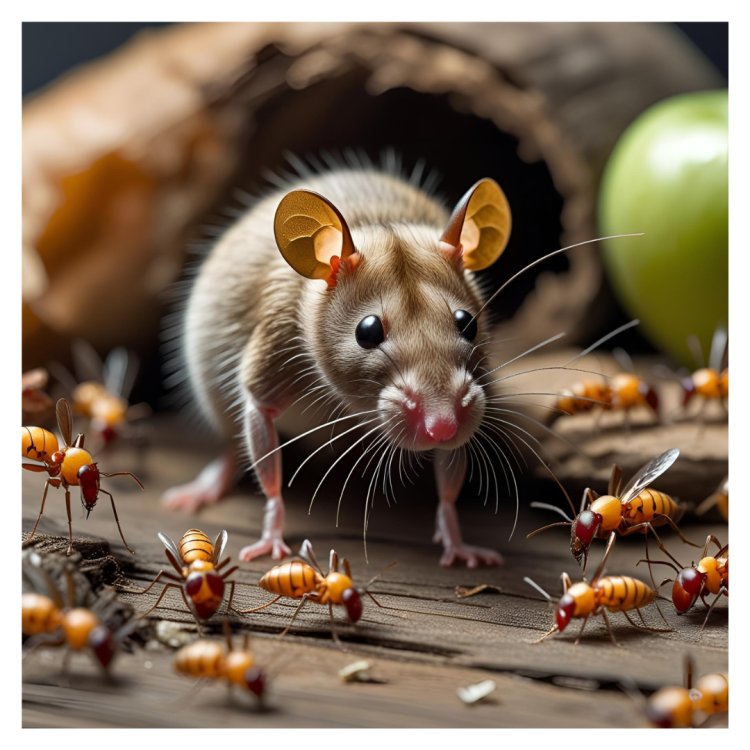Ants, fruit flies, mice & more: How to get rid of (and prevent) common household and backyard bugs and pests
Get rid of ants, flies, mice & more with expert pest prevention tips for your home & yard. Safe, natural, and effective pest control solutions.

Keep Your Home & Yard Pest-Free Year-Round
Pests like ants, fruit flies, mice, and more can invade your home and backyard, especially in warmer months. With the right strategies, you can tackle current infestations and prevent future ones without relying on harsh chemicals. Here's your all-in-one guide.
1. Ants
Why worry?
Ants invade homes seeking food and water, often contaminating surfaces and entering via tiny cracks.
How to get rid of them:
-
Seal entry points: Inspect walls, windows, door frames, and baseboards for gaps. Use caulk or weatherstripping to block their routes.
-
Bait stations: Use gel-based baits rather than sprays – they get carried back to the colony. Non-toxic botanical sprays (like rosemary or peppermint) are also pet-safe and effective.
-
DIY deterrents: Sprinkle ground cinnamon, black, or cayenne pepper near trails and entry points. Pepper can even be mixed with water for a homemade spray.
How to prevent:
-
Keep kitchen counters crumb-free and store food in sealed containers.
-
Regularly empty bins with tight lids.
-
Maintain dry environments; moisture attracts ants.
2. Fruit Flies & Drain Flies
Why worry?
Fruit flies (tiny gnats) thrive around ripe produce, open liquids, and moist organic matter.
How to get rid of them:
-
DIY vinegar trap: Fill a bowl with apple cider vinegar, a pinch of sugar, and dish soap. Cover with cling film, poke holes—gnats go in and can’t escape.
-
Tackle drain flies: Pour a bleach-water solution down drains, or clean with hot, soapy water.
How to prevent:
-
Store fruits in the fridge or sealed bins.
-
Clean spills and take out trash promptly.
-
Install screens on doors and windows.
3. Mice & Rodents
Why worry?
Mice spread disease, chew wiring, and reproduce rapidly indoors.
How to get rid of them:
-
Seal holes: Anything larger than 6 mm—seal with steel wool, mesh, or quick-setting cement.
-
Humane trapping: Use traps angled against walls, out of pets’ reach.
-
Scent deterrents: Cinnamon and peppermint are known to repel rodents. Use plug-in fresheners or soaked cotton balls.
How to prevent:
-
Keep food in airtight containers.
-
Declutter storage areas—mice nest in hidden, undisturbed spaces.
-
Inspect annually for structural gaps.
4. Wasps & Hornets
Why worry?
These stinging insects can build nests in eaves, bins, and sheds, posing serious risks to people and pets.
How to get rid of them:
-
Always hire a professional for nest removal.
-
Use peppermint-oil-infused sachets around patios, shaded areas, and bin lids.
How to prevent:
-
Keep outdoor bins sealed.
-
Regularly inspect sheds and overhangs in spring to catch new nests early.
5. Mosquitoes & Flying Insects
Why worry?
Biting nuisance and disease risk transmitter.
How to get rid of them:
-
Eliminate standing water: Remove or refresh water in plant saucers, gutters, and bird baths.
-
DIY repellents: Citronella candles, essential oils (such as eucalyptus, lavender, and lemongrass), placed strategically, help deter mosquitoes. Fans disrupt their flight patterns.
How to prevent:
-
Maintain moving air with outdoor fans.
-
Use yellow bug lights or LED bulbs designed to repel insects.
6. Moths & Silverfish
Why worry?
They damage fabrics, paper, and storage items.
How to get rid of them:
-
Use sachets filled with rosemary, lavender, or bay leaves in closets.
-
Silverfish can be trapped using damp newspaper rolls placed overnight.
How to prevent:
-
Wash natural-fiber garments before storing.
-
Keep storage areas dry and ventilated.
7. Slugs & Garden Pests
Why worry?
They damage plants and may enter damp indoor spaces.
How to get rid:
-
Scatter shallow beer traps in the garden to attract and drown slugs.
-
Around entryways, use crumbled eggshells or cereal as barriers.
How to prevent:
-
Keep pile-free, dry zones near house foundations.
-
Monitor garden for early signs of pests like aphids or cabbage moths. Using neem oil or water sprays can deter many garden pests.
8. Roaches, Centipedes & Bed Bugs
Roaches:
-
Use boric acid, diatomaceous earth, or gel baits.
-
Seal cracks and fix moisture issues.
Centipedes:
-
Seal entry points and remove other pests (their food source). Use targeted sprays or diatomaceous earth.
Bed bugs:
-
Wash bedding at ≥60 °C and freeze smaller items to kill eggs. Vacuum mattresses.
-
Tea-tree oil sprays may help at the early stages.
9. Stink Bugs
-
Seal cracks around windows, doors, and utility pipes.
-
Vacuum them with a HEPA-filter vacuum and dispose of them outdoors.
-
Spray them with pyrethrin-based products or collect in soapy water traps.
Pro Pest-Control Tips
-
Act early – Don’t wait until infestations are widespread.
-
Adopt Integrated Pest Management (IPM): combine sealing, sanitation, and targeted treatments.
-
DIY ≠ permanent solution: DIY remedies work for minor issues, but call pros for dangerous or persistent infestations.
-
Keep up with seasonal inspections: Critters often return without ongoing preventative care.
Final Takeaway
Pest control doesn’t have to rely on harsh chemicals. A smart mix of barrier sealing, traps, natural deterrents, and proactive maintenance goes a long way in keeping your home and yard pest-free. When infestations are serious, don’t hesitate to call a professional. Maintain vigilance, and you’ll enjoy a safe, clean, pest-free environment all year long.













